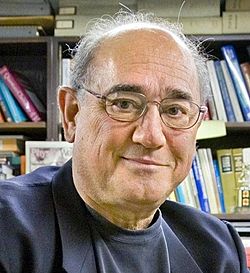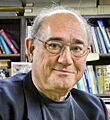Alexander Pines facts for kids
Quick facts for kids
Alexander Pines
|
|
|---|---|
 |
|
| Born | June 22, 1945 |
| Died | November 2, 2024 (aged 79) |
| Alma mater | Massachusetts Institute of Technology |
| Known for | Cross-polarization NMR spectroscopy |
| Awards | Russell Varian Prize (2008) Faraday Lectureship (2004) Glenn T. Seaborg Medal (2003) ForMemRS (2002) Dickson Prize (2001) Irving Langmuir Award (1998) Centenary Prize (1993) Wolf Prize in Chemistry (1991) Guggenheim Fellowship (1988) Bourke Award (1988) Camille Dreyfus Teacher-Scholar Awards (1976) |
| Scientific career | |
| Fields | Chemistry |
| Institutions | University of California, Berkeley Lawrence Berkeley National Laboratory |
| Doctoral advisor | John S. Waugh |
| Doctoral students | Robert Tycko, Warren S. Warren,Mei Hong |
Alexander Pines (born June 22, 1945 – died November 2, 2024) was an important American chemist. He was a professor at the University of California, Berkeley. He also worked at the Lawrence Berkeley National Laboratory.
Professor Pines was known for his amazing work with nuclear magnetic resonance (NMR). This is a special way to study what things are made of.
Contents
Early Life and Education
Alexander Pines was born on June 22, 1945. He grew up in a place called Bulawayo. This city was in Southern Rhodesia, which is now known as Zimbabwe.
He went to college in Israel. There, he studied math and chemistry at the Hebrew University of Jerusalem. In 1968, he moved to the United States.
He earned his Ph.D. in chemical physics from M.I.T. in 1972. Later that year, he started teaching at the University of California, Berkeley. Alexander Pines passed away on November 2, 2024, when he was 79 years old.
What He Studied
Professor Pines was a leader in developing new ways to use nuclear magnetic resonance (NMR). NMR is like using radio waves and magnets to "see" inside materials. It helps scientists understand how atoms are arranged.
He focused on studying solid materials, not just liquids. This was a big step forward in chemistry. He found ways to make NMR much more sensitive. This made it possible to study tiny parts of solid materials, like carbon-13.
His work helped start the modern age of solid-state NMR. This is a special type of NMR used for solid objects. He also created new methods to improve how NMR works.
New Ways to Use NMR
Pines and his team found many new ways to use NMR and magnetic resonance imaging (MRI). MRI is a type of NMR used in hospitals to see inside the human body.
Some of his new ideas included:
- Making NMR more sensitive.
- Using NMR outside of a lab, even on the go.
- Using lasers to make NMR signals stronger.
- Creating tiny NMR devices, like "NMR on a chip."
These new methods helped scientists study many different things. They could look at the structure of materials. They also studied how molecules work in living things.
For example, he found a way to use laser-polarized xenon. This helped "light up" certain parts of samples. It made it easier to see them with NMR and MRI.
Awards and Honors
Alexander Pines received many important awards for his work. These awards showed how much his discoveries helped science.
Some of his major awards include:
- The Wolf Prize in Chemistry in 1991. He shared this with another scientist, Richard R. Ernst.
- The Faraday Medal in 2004.
- The Russell Varian Prize in 2008.
He was also a member of important groups. These included the U.S. National Academy of Sciences. He was also a Foreign Member of the Royal Society in London. He received honorary degrees from several universities around the world.
Professor Pines was also recognized for his teaching. He won the University of California's Distinguished Teaching Award. This shows he was not only a great scientist but also a great teacher.
See Also
Images for kids


